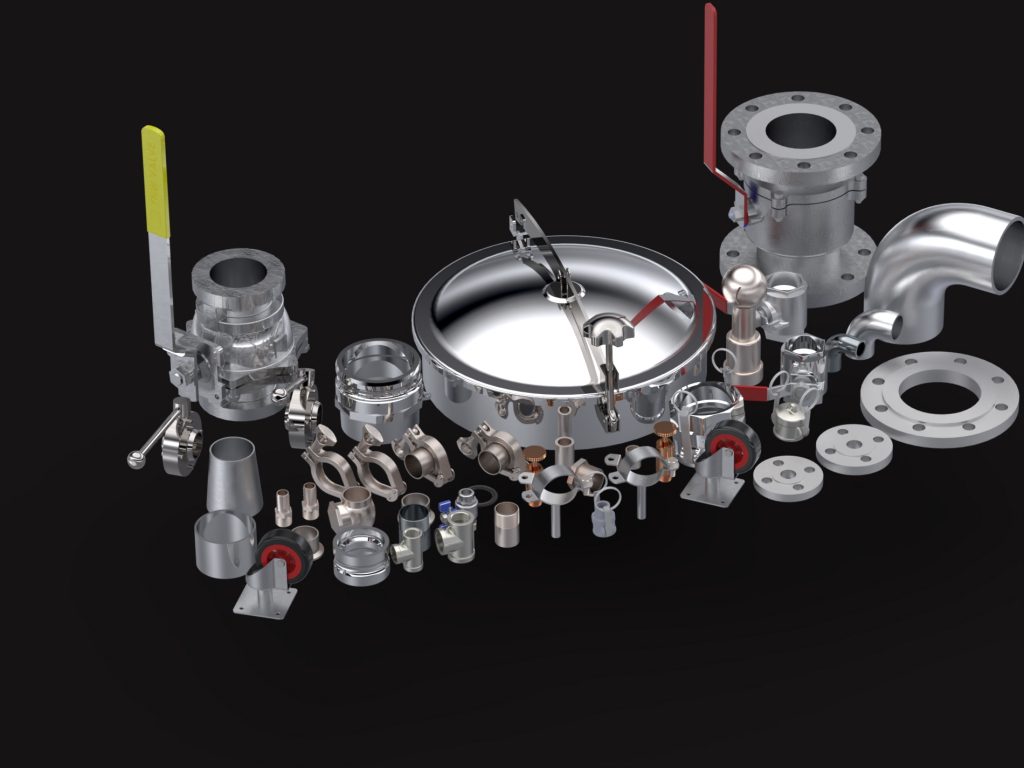What are Stainless Steel Fittings?
Stainless steel fittings are components made of stainless steel and used to connect piping systems. They are frequently used in industries such as chemicals, food, pharmaceuticals, and petroleum.
Stainless steel fittings are an ideal solution for water, gas and liquid transportation thanks to their high corrosion resistance and long-lasting structure.
Types of Stainless Steel Fittings
Stainless steel fittings are classified according to their connection methods and intended uses. Here are the most common types:
1. Welded Stainless Fittings
It allows stainless pipes to be connected to each other by welding.
Provides a more robust and leak-proof connection.
Used in transitions between diameters.
2️. Threaded Stainless Fittings
It has a screw connection system.
It is easy to assemble and disassemble.
It is widely used in small diameter piping systems.
3️.Flanged Stainless Fittings
Used in large diameter piping systems.
It is installed using the bolted connection method.
4️.Clamp Stainless Fittings
It is used in hygienic plumbing systems.
It is easy to disassemble and assemble.
5️.Elbow and T-Elbow Stainless Fittings
Used to change pipe orientations.
There are 45° and 90° angles.
Stainless Steel Fittings Manufacturing Process
The production of stainless steel fittings consists of several meticulously executed steps:
1️.Raw Material Selection:Stainless steel (304, 316, etc.) is specified.
2️.Cut:The steel is cut to appropriate dimensions.
3️.Forming:It is shaped by pressing or forging.
4️.Heat Treatment:The material is hardened and its durability is increased.
5️.Surface Treatment:Glossy or matte surface coatings are applied.
6️.Testing and Certification:It passes quality control tests.
Stainless Steel Fittings Usage Areas
Sectors where stainless steel fittings are widely used include:
Food Industry:It is preferred because it is hygienic and durable.
Chemistry and Petrochemistry:It is resistant to acids and chemicals.
Marine:It offers high corrosion resistance against salt water.
Aviation and Defense:It is resistant to high pressure and temperature.
Water Purification:It can be used safely thanks to the hygienic structure of stainless steel.
Stainless Steel Material Classes
The most common material classes from which stainless steel fittings are produced:
Material Type | Features |
304 Stainless Steel | Suitable for general use, it has moderate corrosion resistance. |
316 Stainless Steel | It is highly resistant to sea water and chemicals. |
321 Stainless Steel | Used for high temperature applications. |
904L Stainless Steel | It is preferred in applications requiring extreme corrosion resistance. |
Things to Consider When Choosing Stainless Steel Fittings
Purpose of Use:Material and type appropriate to the sector should be selected.
Pressure and Temperature Resistance:It must be compatible with operating conditions.
Connection Type:Welded, threaded or flanged type should be determined according to need.
Quality Certificates:Compliance with standards such as ISO and ASTM should be checked.
Frequently Asked Questions (FAQs) About Stainless Steel Fittings
1️.Do stainless fittings rust?
No, quality stainless steel fittings are resistant to corrosion. However, improper maintenance or use of inferior materials can lead to rust.
2️.How are stainless steel fittings prices determined?
Prices vary depending on steel grade, diameter, production method and market conditions.
3️.What temperatures are stainless steel fittings resistant to?
304 stainless steel is resistant to 870°C, and 316 stainless steel is resistant to 925°C.
4️.Where to buy stainless steel fittings?
It should be purchased from reliable industrial suppliers and manufacturers. Certified products should be preferred.
5️.Should threaded or welded fittings be preferred?
Threaded fittings should be preferred in low-pressure systems, and welded fittings should be preferred in systems requiring high pressure and sealing.
6️.How to maintain stainless steel fittings?
Long-lasting use can be ensured with regular cleaning and chemical resistance tests.
Stainless steel fittings With its durability and long-lasting structure, it offers a reliable solution for industrial and domestic uses. When used with quality materials and the correct connection method, it delivers excellent performance in plumbing systems.


